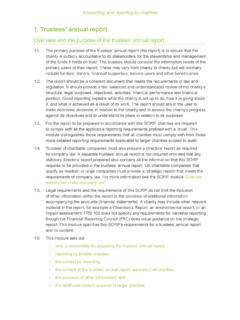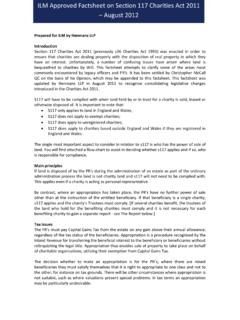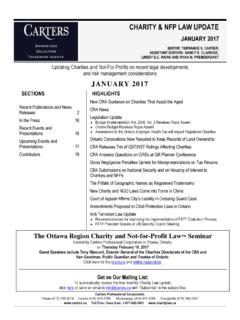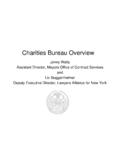Transcription of How donors choose charities - CGAP
1 Centre for Charitable Giving and Philanthropy Occasional paper 1 How donors choose charitiesFindings of a study of donor perceptions of the nature and distribution of charitable benefitBeth Breeze CGAP OCCAsiOnAl PAPer 1 HOw donors choose charities BetH shIN IsbN 978 1 907376 05 4 There are tens of thousands of charities in the UK, and even the most generous donors can support only a tiny fraction of these good causes. This paper examines how donors go about choosing which organisations to give their money on interviews with 60 committed donors , it explores how people define charity, what they think about charitable beneficiaries, and the rationale behind their giving widespread assumptions that need is the primary driver of charitable donations, this study finds that giving decisions are also based on other factors, notably donors tastes, personal experiences, perceptions of charities competence and a desire for personal impact.
2 CGAP fUndersEsRCOffice for Civil society scottish governmentCarnegie uK TrustCGAP PArTiCiPATinG insTiTUTionsCass business schooluniversity of Edinburgh business schooluniversity of Kent university of southamptonuniversity of strathclydeNCVOAboUT The AUThorDr beth breeze is a researcher within the EsRC Centre for Charitable giving and philanthropy, based at the university of 19/6/10 00:27:57 Centre for Charitable Giving and Philanthropy Occasional paper 1 How donors choose CharitiesFindings of a study of donor perceptions of the nature and distribution of charitable benefitBeth Breeze Published by Alliance Publishing TrustCopyright 2010 Beth BreezeCreative Commons Attribution Noncommercial No Derivative Works are free to share to copy, distribute, display, and perform the work under the following conditions:Attribution: You must attribute the work as How donors choose charities 2010 Beth : You may not use this work for commercial Derivative Works: You may not alter, transform or build upon this any reuse or distribution, you must make clear to others the licence terms of the SB N 978 1 907376 05 4 Alliance Publishing Trust 1st floor, 25 Corsham Street London N1 6DR UK charity number: 1116744 Company registration number: 5935154A catalogue record for this book is available from the British in Akzidenz Grotesk Design by Benedict Richards Printed and bound by Hobbs the Printers, Totton, Hampshire, UKThis book is printed on FSC approved or g 1996Fo re st St ew ar ds hi pCou nc i lCert no.
3 SA- COC-001530 Mixe d Sour ce sPr oduct gr ou pfro m we l l -m an ag edfore st sand ot he rcon tro l l e dsou rc esContents About the ESRC Centre for Charitable Giving and Philanthropy 5 Acknowledgements 7 About the author 7 Executive summary 9 Introduction 11 Methodology 15 Findings 18 Discussion: three theoretical perspectives on the data 39 Implications for policy and practice 44 Future research directions 52 Conclusion 53 Appendix: Interview schedule 55 References 57 5 About the ESRC Centre for Charitable Giving and PhilanthropyThe ESRC Centre for Charitable Giving and Philanthropy (CGAP) is the first academic centre in the UK dedicated to research on charitable giving and philanthropy. It aims to develop charitable giving and philanthropy through building an evidence base and bringing researchers and practitioners together to share knowledge and expertise. CGAP is funded by the ESRC, the Office for Civil Society, the Scottish Government and Carnegie UK Trust.
4 With three main research strands, CGAP is a consortium of institutions working in a hub and spokes model. CGAP Hub Based at Cass Business School, the Hub coordinates CGAP and its dissemination, knowledge transfer and stakeholder engagement activities, in partnership with NCVO. It is directed by Professor Cathy Pharoah (Cass Business School) and Professor Jenny Harrow (Cass Business School). For further information, email or Spoke 1 Based at the University of Strathclyde, Spoke 1 focuses on individual and business giving, with a major research programme on entrepreneurial philanthropy. It is directed by Dr Eleanor Shaw (University of Strathclyde). For further information, email Spoke 2 Based at the University of Southampton and the University of Kent, Spoke 2 has a number of research programmes on 6 the theme of social redistribution and charitable activity. It is directed by Professor John Mohan (University of Southampton).
5 For further information, email Spoke 3 Based at the University of Edinburgh Business School and Cass Business School, Spoke 3 has the research theme of the institutions of giving and focuses on charitable foundations, household giving and government. It is directed by Professor Jenny Harrow (Cass Business School).For further information, email further information on CGAP, visit 7 Acknowledgements This paper is an output of a project funded by the Economic and Social Research Council, UK (Award No: RES 593 25 0003). It is part of a wider collaborative study being conducted at the University of Kent and the University of Southampton, entitled Charity and Social Redistribution: Quantitative and Qualitative Perspectives , within the ESRC Centre for Charitable Giving and Philanthropy. The author is grateful for the funding, which comes from the ESRC, the Office for Civil Society, the Scottish Government and Carnegie UK thanks to CAF ( charities Aid Foundation), especially to Liz Goodey, Kamaljeet Bains and Alec Evans, for their invaluable help in recruiting interviewees for this study.
6 And sincere thanks to the 60 CAF account holders who so generously gave of their time; it is impossible to do this type of research without the goodwill and gift of time given by also to Elaine Alden for help with coding the data, and to Iain Wilkinson, John Mohan and Cathy Pharoah for their comments on earlier versions of this the authorDr Beth Breeze is a researcher within the ESRC Centre for Charitable Giving and Philanthropy, based at the University of Kent. Contact 9 Executive summary This paper is concerned with the question of how donors select charitable beneficiaries, and the extent to which assessments of need are a factor in giving decisions. The study is based on interviews with 60 committed donors , representing a spread of gender, age and income levels. There is a widespread belief that charities exist primarily to help needy people and that the desire to meet needs is a key criterion in the selection of charitable beneficiaries.
7 However, this study finds that people do not give to the most urgent needs, but rather they support causes that mean something to them. In particular, the study finds four non needs based criteria that commonly influence donors decision making: donors tastes, preferences and passions, acquired as a result of an individual s social experiences. These motivate many giving decisions, even among donors who perceive themselves to be motivated by meeting personal and professional backgrounds, which shape their philanthropic autobiographies and influence their choice of perceptions of charity competence, notably the efficiency with which they are believed to use their money, often judged on the basis of the quality and quantity of direct desire to have a personal impact, such that their contribution makes a difference and is not drowned out by other donors and government Given the voluntary nature of charitable activity, these are not surprising conclusions.
8 Giving and philanthropy have always been supply led rather than demand driven: the freedom to distribute as much as one wants, to whom one chooses, is what distinguishes giving from paying tax. Yet the methods used to encourage donations tend to assume that philanthropy depends on objective assessments of need rather than on donors enthusiasms. The tendency to overestimate the extent to which people act as rational agents results in fundraising literature that often focuses on the dimensions and urgency of the problem for which funding is sought. The assumption underlying this approach is that donations are distributed in relation to evidence of neediness, when in fact much giving could be described as taste based rather than needs based .Theoretical models of decision making are used to demonstrate that donors are restricted not only by the amount of money they have available to give away but also by limitations in their ability to gather information, cognitively process the merits of alternative recipients, and dedicate time to this decision making process.
9 The findings confirm that donors find it difficult to make decisions about charitable recipients, and that they use a range of strategies to assist their decision making, including:Constructing self made classifications and mental maps to help cope with the complexity of the charity heuristics, or rules of thumb , to filter potential charitable assigning certain causes as intrinsically worthy or unworthy of paper concludes that a better understanding of donors rationalities is necessary for both policy makers and fundraising practitioners, in order to avoid making erroneous assumptions about the meaning and motivation behind giving decisions. 11 Introduction It is only in our decisions that we are important. Jean Paul SartreMuch attention has been paid to questions concerning how many donors give, how much they give, what sorts of people give and why people give, but there has been little attention paid to the specific question of how donors choose which charities to support.
10 This focus on data gathering in previous studies is understandable, as there has been an urgent need for information on the patterns and distribution of donations. But it has left untouched many important questions about the meanings and motivations behind specific giving decisions; this paper attempts to begin to fill that gap. Making decisions about which charities to support is a complex problem that has significant consequences for donors , recipients, non recipients and wider society. Greater insight into donors meanings and motivations should increase our understanding of the distribution of charitable donations, and provide guidance on what it might take to change those patterns. There are over 180,0001 registered charities in the UK, an estimated 20,000 people employed as professional fundraisers2 and many tens of thousands more people who voluntarily ask others to donate money to The vast range of giving opportunities creates a difficult situation for those 1 According to the Charity Commission website in May 2010, there are 159,860 main charities and a further 20,981 subsidiary and constituent charities on the Register of charities , making a total of 180,841 registered The most recent figure relating to the size of the fundraising profession was published in Charity Trends 2007, which states that in 2005/06, 24,960 people were employed in fundraising and administrative roles within the top 500 charities (p181).








